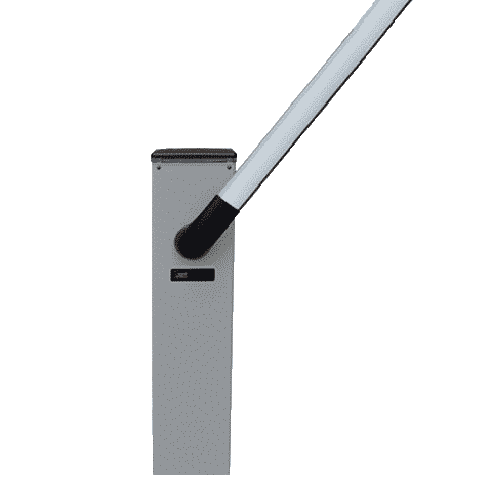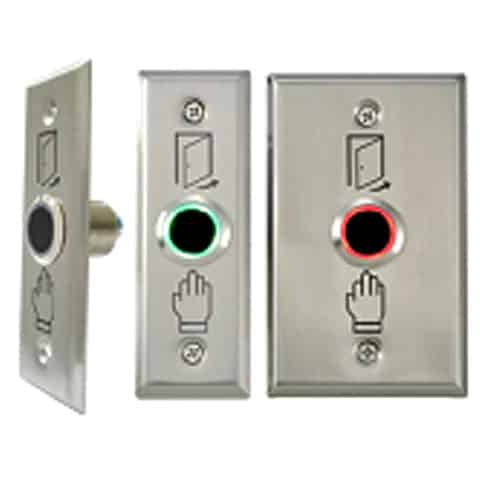Category: Pedestrian Access Control
Radar Detector v Loop Detector – which is better?
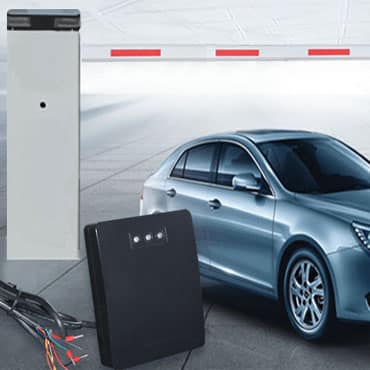
The choice between radar detectors and loop detectors greatly depends on the specific requirements of the application, cost considerations and the desired level of accuracy and reliability.
This article highlights the differences between the two technologies in the context of automatic boom gate safety installation. Both radar detectors and loop detectors can be used for vehicle detection, but the technology used operates differently on each device and each with Pros and Cons.
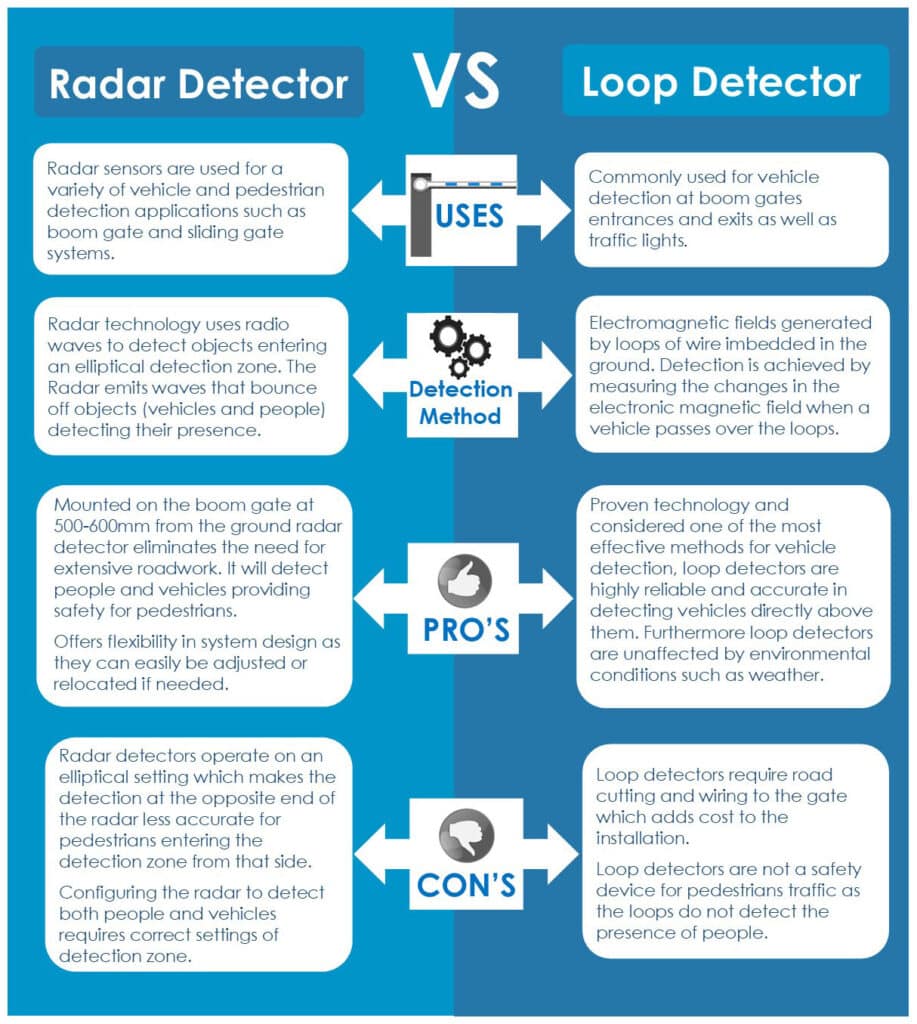
How the different boom gate safety technologies work
Radar Detector – radio waves
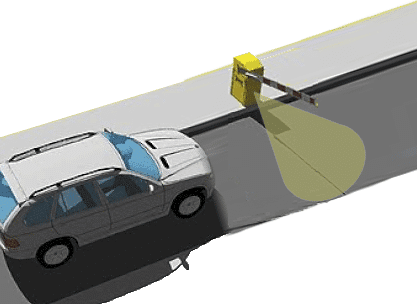
Rotech’s RD6 Radar Detector consists of a radar transmitter, receiver and antenna in one small unit. The radar unit emits radio waves which detect the reflection of these waves off any object (motor vehicle and people) approaching the boom gate.
By integrating the RD6 radar detector with the boom gate control system you can automate the opening and closing of the boom barrier based on the presence or absence of vehicles.
If a vehicle is detected approaching the boom gate, the control mechanism activates the motor to raise the boom gate barrier to allow the vehicle to pass. When the vehicle or pedestrian has exited the detection area the control mechanism lowers the boom gate barrier to restrict access.
Loop Detector – electromagnetic device
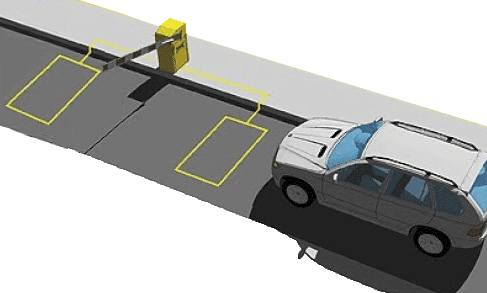
Rotech offers a wide range of different types of loop detectors that operate similarly but can be fitted in different ways (11-pin or flat pack for confined spaces and rail mount). A loop detector consists of loops of wire embedded in the pavement near the boom gate barrier that generates an electromagnetic field. When a vehicle passes over the loop, it disrupts the electromagnetic field, triggering the detection of the vehicle.
When the signal processing unit determines the presence, size and speed of the vehicle the automatic boom gate control mechanism activates the motor to raise the boom gate to allow the vehicle to pass.
When the vehicle passes over a second set of loop detectors on the exit side it triggers the gate controller to lower the barrier gate. In summary, both radar detectors and loop detectors have their strengths and weaknesses when it comes to detecting vehicles for controlling an automatic boom gate – which one to use depends on the environment in which it is installed.
Competitively priced, all our gate safety equipment solutions comply with international standards. For reliable accurate detection select from our extensive range of loop detectors and logics, vehicle detectors, safety beams, and safety light curtains to secure your gate or entrance.
Contact us to discuss whether a radar detector or loop detector is best suited to your application for safe, reliable security around an automatic boom gate.
5 Benefits of Installing Turnstiles and Flap Barriers
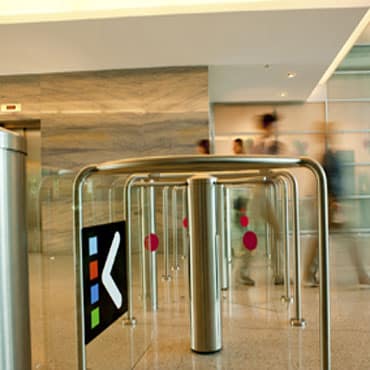
Turnstile gates and flap barriers are an essential aspect of both modern building and store security, as well as general access control for venues.
If you are considering installing these systems in your building, you are taking a proactive step towards creating a more secure environment. These systems offer a range of benefits that make them a valuable investment for any venue looking to invest in entrance security.
In this article, we will delve into the advantages of turnstiles and flap barriers and why they are a necessary addition to any security plan. Whether you run a public venue, an office building, or any other type of facility, there are a wide range of benefits to these security gates that can help to ensure the safety and security of your premises and personnel.
What Are Turnstiles and Flap Barriers?
Turnstiles and flap barriers are automated systems made up of sensors, barriers and access control systems that allow or prohibit entry or exit. They come in a number of different materials. designs and sizes to suit different needs, venues and applications.
Flap barriers have two flaps on either side that serve as physical barriers, limiting pedestrian access to a venue.
Turnstile gates can be optical, which use infrared sensors to detect approaching people, and can operate with or without barriers. They can also be full height or waist high. Full-height turnstiles have durable rotating barriers that extend from the ceiling to the floor much like revolving doors and provide enhanced security. Waist-height turnstiles, on the other hand, have a tripod barrier arm that rotates at waist level.
Why Install Turnstiles and Flap Barrier Systems?
You might think that having automated doors with access controls on your premises is a good enough security measure, but turnstiles and flap barrier gates turn this up a notch and offer so much more:
1. Increased Security and Control
While automatic doors with access controls offer some security, they’re often prone to ‘tailgating’, wherein intruders or unauthorised persons follow immediately after those with authorised access when they enter or exit premises. This compromises the area’s security, and also makes it difficult to track the exact number and identities of those coming in and out of a supposedly secure area.
With turnstiles or flap gates, such instances can be eliminated. They allow for only one person to pass at a time, with the necessary valid credentials. After letting an authorised person pass, barriers close immediately. Some models can even detect tailgating, loitering or forced passage and trigger an alarm.
Letting just one person pass at a time gives security personnel time to inspect any suspicious characters, spot potential trouble and intervene if necessary. This also works well for crowd control. With automatic doors you could have any number of people passing through without valid access any time the doors open. With turnstiles and flap barrier gates, however, only one person at a time may pass, which allows you to more effectively control large numbers of people entering venues such as stadiums, amusement parks and sports venues.
2. Full Access Control Integration
Turnstile installations are a crucial aspect of modern building security and access control. Working in conjunction with CCTV cameras, automatic doors and other security equipment, turnstiles and flap barriers can effectively secure premises. If an intruder or unauthorised person is detected at the turnstile, an alarm can quickly be triggered, doors locked down and cameras turned on to detain the threat. With the integrated access control system, you’ll also be able to collect information such as the specific identities, and time and location of every person coming and going through exit and entrance points.
Additionally, turnstile entry systems provide an efficient and secure way to manage the flow of people in and out of a building. This helps to reduce long lines and waiting times, making it easier for authorised personnel to enter and exit the building.
Not only do turnstile entry systems provide a secure and efficient way to manage the flow of people in and out of a building, they also reduce the need for physical guards. This results in cost savings and improved overall building security, as the system can be monitored remotely and instantly respond to potential threats. The use of these systems also helps to minimise human error and reduces the likelihood of unauthorised individuals slipping through unnoticed.
3. Time and Cost Savings
With these systems in place there is a lesser need for security or front desk personnel to check and verify identification. Authorised persons can simply present their ID cards or biometrics and gain access. This saves you from having to pay personnel to constantly man exit and entrance points, and also saves time by streamlining the exit and entrance of persons.
Another cost-saving advantage of turnstiles and flap barriers is their low maintenance requirements. These systems are designed to be durable and long-lasting, so they can operate efficiently even with heavy usage. This results in lower maintenance and repair costs compared to traditional security systems. Additionally, the integration of turnstiles and flap barriers with access control systems and security equipment such as CCTV cameras can lead to a more streamlined and efficient security setup, reducing the need for multiple separate systems and their associated costs.
4. Operational Flexibility
Turnstile and flap barrier systems offer a high degree of flexibility and customization to meet the unique needs of your operation. Depending on your specific requirements, you can configure the system to allow for a one-way or bi-directional flow of people. For instance, during business hours when employees are entering the building, the turnstiles can be set to entry-only mode. This can then be switched to exit-only mode after hours when employees are leaving the building.
In addition to controlling the flow of people, turnstiles and flap barriers also offer the ability to lock down access points during non-operational hours. This provides an added layer of security and helps to prevent unauthorised entry. Alternatively, in the event of an emergency, you can switch the turnstiles and flap barriers to free pass mode, allowing people to move freely through the exits without requiring authorisation.
5. Additional Features
Turnstiles and flap barriers offer a highly effective way to monitor and manage the flow of people in and out of a venue. In addition to securing entry points, these systems can also be used to gather valuable data and insights about your visitors. For example, you can use turnstiles to count admissions and track the number of people in your venue at any given time. This information can be used to determine peak traffic hours and to ensure that your facility is staffed appropriately to meet demand. You can also use the data to determine if there are still people in the area after closing time, helping you to ensure the safety of your guests and employees.
Another important application of turnstiles and flap barriers is enforcing payment at venues. For example, at amusement parks and sports venues, turnstiles can be configured to only allow entry to those with a valid ticket or access key. This helps to prevent unauthorised entry and ensures that only paying customers can access your facilities. The same applies to public transportation terminals, where turnstiles can be used to control access to platforms and ensure that only ticketed passengers are able to board.
Need Help? Get In Contact!
To learn more about how turnstiles and flap barriers can benefit your business, or inquire about the best access control systems for your needs, get in touch with Rotech today on (07) 3205 1123.
TriStar F21 Turnstile Plays Vital Role Securing Entry to Cross River Rail Worksites

MORE TRAINS MORE OFTEN | The Qld Government’s $5.4bn Cross River Rail project has progressed from its early works in 2017, to major construction in 2019 and is now well on its way to being delivered.
Key worksites have been established at Woolloongabba, Boggo Road, Albert Street, Roma Street and Exhibition/RNA Showgrounds to build the new underground rail system that will streamline Brisbane’s public transport system.
The project aims to deliver a new 10.2-kilometre rail line from Dutton Park to Bowen Hills, including 5.9 kilometres of twin tunnels under the Brisbane River and CBD by 2025. While the engineering feats involved are staggering, in the age of COVID, the management of the large workforce is equally as impressive.
DELIVERING INTELLIGENT ACCESS CONTROL
Demolition, underground excavation, tunnelling and construction are high risk, hazardous activities, but even more so when carried out in built-up city locations.
With a project as large and complex as Cross River Rail, strict compliance with workplace health and safety standards minimises risks to workers. High-level security measures keep people working, living and moving around the work areas out of harm’s way.
Knowing who is where on all work sites at any time, preventing access to unauthorised people, controlling access to high risk or restricted areas and managing the movement of the site-based workforce, contractors and visitors is a mammoth undertaking.
Damstra’s high-tech integrated workforce management software manages, monitors, tracks, and controls the access rights of everybody entering the project work sites.
Requiring proven, reliable entry and exit barriers to team up with Damtra’s sophisticated site access control technology, the Cross River Rail Delivery Authority specified Rotech’s Full Height Turnstiles, Gates and Boom Gates.
EXAMPLE OF OUR TURNSTILES ON THE JOB
Work at the Albert Street station has been relentless and fast-paced, involving excavation and retention activities including rock hammering, controlled blasting, drilling, soil removal, installing propping systems, formwork and concreting.
Sections of road have been closed during this activity but the pedestrian thoroughfare has been maintained. This is a massive planning challenge for the team.
“Albert Street is very different, we’re a lot more constrained in size. We have thousands of people walking through the site and we have residential towers beside us”
– Dusan Ilac, TSD Area Engineering Manager, Cross River Rail

Rotech’s Australian-made TriStar F21 full height turnstiles and security gate
playing a vital security and safety role at the Albert Street Site
The TriStar F21 full height turnstiles and wide access security gates work in real-time with Damstra’s multi-site access control system to only allow compliant workers and authorised contractors entry.
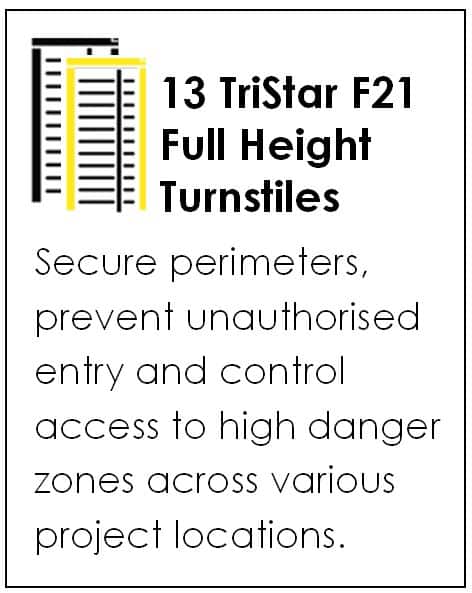
- No Tailgating: the design restricts access to one person at a time, preventing tailgating of an unauthorised person by following an authorised one
- Convenient: the high, wide security gate entrance allows easy entry for personnel wearing hard hats, carrying tools and bulky equipment
- Bi-directional: the turnstile can be set to entrance only, exit only or used in both directions. The status indication system indicates whether the turnstile is secure i.e. the entry/exit is closed or freewheeling
- High capacity drive mechanism: has a 5-year guarantee
- Battery back-up: on power failure, the TriStar’s unique relay and battery backup system automatically switches to battery back-up and activates a warning siren to indicate that the power supply has failed. The turnstile can function for up to 3000 cycles without mains power.
When personnel swipe their access cards the access control system records and monitors who is on-site and where. This is critical information in an emergency when site management and safety crews need to know the location and how many personnel are on site.
TRISTAR F21 FULL HEIGHT TURNSTILE
Ideal for construction sites, a portable base and solar power options allow it to be used in remote locations or situations without access to mains power. Easily relocatable the turnstile and gate can be moved to different locations as the project progresses.
The TriStar is the first Australian-made product of its type, created to provide customers with a safe and secure method of access control with multiple optional features and customisation options.
If you would like further information about this or other safety and security solutions call Vince on 07 3250 1123 or email us at info@rotech.com.au
References: Information relating to Cross River Rail project activity was sourced from the official State of Queensland website at https://crossriverrail.qld.gov.au – Last Accessed 25 August 2021
Case Study | Warehouse Safety is No Accident

Confectionery manufacturer is not taking any risks with its workers lives
Recognised as one of Australia’s best and safest places to work, a major confectionery manufacturer is vigilant about keeping its employees and visitors safe from workplace hazards.
Increasing throughput from the factory, an expanding workforce and a growing fleet of forklifts travelling through the factory and the warehouse has meant maintaining its excellent record is a constant challenge.
An indispensable piece of equipment for industrial facilities such as warehouses, manufacturing and logistics, forklifts are frequently linked with workplace injuries in these sectors.
Typical activities such as reversing, manoeuvring, turning blind corners and negotiating bottlenecks mean forklifts present the greatest danger of serious injury to workers.
PEOPLE VS FORKLIFTS – ADDRESSING THE ISSUE
The most effective method of reducing accidents in factory and warehouse situations is to keep vehicles and people separate with clearly defined routes for each.
WorkSafe Australia’s Workplace Traffic Management Guide offers a range of measures for managing identified risks. These include delineating areas using floor markings, traffic directions, signed walkways and guide rails which provide visual cues and warnings for workers.
However, it is not possible to eliminate interactions between pedestrians and vehicles altogether. While signage and barriers are effective at keeping workers and forklifts within their designated traffic zones, intersections and crossings pose a high risk of a collision or accident.
Using automated gate configurations to manage access in shared forklift/pedestrian zones provides an additional layer of protection. To cross a shared intersection a worker must activate a switch to close the boom gates and open the pedestrian swing gates before they can proceed across the walkway. After crossing safely, the worker activates another switch which automatically closes the swing gates and raises the boom poles to allow the forklifts access.
Warehouse Safety Gates in Action
- Pedestrian swing gates normally remain closed and the boom gates open, allowing forklift traffic to move freely around the warehouse
- To cross pedestrians wave their hand across a touchless activation switch.
- The boom gates close preventing access by any vehicular traffic and the swing gates open to allow the pedestrians to proceed through the shared zone.
- Once the pedestrian has crossed they swipe the button on the other side.
- The swing gates close behind the pedestrian and the boom gates are automatically raised allowing access for the vehicular traffic again.
WORKPLACE TRAFFIC MANAGEMENT – MAKING IT WORK
After purchasing automatic pedestrian swing gates from us previously, factory management was confident Rotech’s products would more than meet their requirements.
Impressed with the performance of our Bulwark HB Automatic Swing Gates in the past, these were the logical choice to manage pedestrian access to shared zones in the factory and warehouse thoroughfares.
Frequency of use, advanced safety features and tough construction made our industrial Bionik AG boom gates ideally suited for managing forklift access through these areas.
Using SafePass S-Wave touchless activation switches to operate the gates offered the best solution. Small enough to be mounted on the barrier rails, they feature low interference infrared technology that provides contactless activation, in keeping with the factory’s hygiene policies.
MORE ABOUT ROTECH PRODUCTS USED FOR THIS SAFETY SOLUTION
BIONIK AG 3-8 METRE AUTOMATIC BOOM GATE
Warning lights on the top of the boom gate cabinet and the boom pole activate to warn any incoming forklift operator to be cautious and aware the gate is moving.
Suited to industrial applications, the Bionik AG operates reliably for up to 5,000 operations per day. Its 3mm thick reinforced cabinet, heavy-duty springs and a boom pole with internal braces makes it tough and durable. Advanced features provide smooth operation, tough 100% duty cycle and low power consumption.
Digital thinking technology: The AG’s unique design offers precise speed control, easily programmed multi-function digital controller and ultra-responsive performance.
Superior safety sensing: The motor design allows instant reversing of the boom pole if any safety devices are activated, or the pole is obstructed.
BULWARK HB AUTOMATIC SWING GATES
A fast opening swing gate the Bulwark allows pedestrians to pass through quickly while a number of in-built safety mechanisms ensure the highest levels of safety.
Tough: The extremely strong 6 mm steel housing ensures protection against abuse and damage from knocks.
Versatile: The gate can be operated using touchless sensors, push buttons, remote control, PE beam or roof-mounted radar.
Safe: The Bulwark HB’s electronic safety sensing is very effective when an obstruction is sensed the gate stops. In the event of an emergency, the gate arm can be manually pushed open and an alarm will sound.
SAFEPASS S-WAVE INFRARED MINI ACTIVATION SWITCH
The SafePass S-Wave is a compact mini design, waterproof, low voltage touchless activation switch featuring adjustable range and sensitivity.
Widely used in commercial, industrial and public areas the S-wave can be mounted just about anywhere making it suitable for most access control situations.
The S-Wave offers 100,000 hours of no interference performance, an in-built microcontroller with a power-on self-testing function.
Whether it is a food manufacturing facility or a hospital – Rotech has been at the forefront of innovating new ways to create efficient access control solutions for virtually any situation. For more information about our products Alan us (07) 3205 1123 or email us
Minimise Workplace contamination using our advanced technology door activation sensors
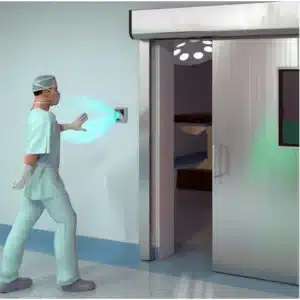
Are you going back to work soon? With the new normal ahead of us, the safety of employees, customers and clients is a top priority. Along with social distancing, your workplace needs to reduce contact points to minimise the spread of bacteria, infection, and viruses.
This can be managed with Rotech’s SAFEPASS ClearWave and J-Wave, the advanced sensor technology for door automation.
What makes SAFEPASS the key against contamination?
Wave but don’t touch! Rotech provides the “touchless” sensor solution to secure automatic access through doors, thereby reducing contact with surfaces that may be entry points for viruses. Both ClearWave and J-Wave have motion activation sensors that incorporate the latest microwave and infrared technologies into a sleek slimline design that makes mounting a breeze.
SAFEPASS ClearWave Door Activation Sensor
This non-touch door activation switch is used to maintain sterile environments and features an adjustable touchless range from 5 to 40 cm. Here are some of its features that makes it a top choice for work spaces:
- Flush mounted
- Water-resistant
- Hygienic
- Sleek design
- Versatile
This senosor is designed for installations where hygiene is paramount such as hospitals, operating theatres, pharmaceutical facilities, clean rooms, food processing plants and chemical industry applications.
SAFEPASS J-Wave Door Activation Sensor
This sensor is a non-touch door activation switch with a detection distance of up to 30 cm. Its low-profile design facilitates a tidy installation on narrow door frames or guide rails. Some of its features include:
- Jamb-style mounting
- Hygienic
- Active infrared technology
- Tough polycarbonate
This activation sensor can detect very fast hand movements in front of the switch body. It’s designed to reduce the spread of germs and improve accessibility in hospitals, healthcare, industrial, retail and commercial settings. Because it’s illuminated by LED, you can easily locate it in dimly lit environments.
Why choose Rotech’s SafePass?
- Versatile application. The consistent and fast reaction times of SafePass makes up for a reliable sensor performance in a wide range of installation and climatic environments.
- Reduces building energy loss. Its accurately adjustable detection reduces false door activation, cutting building energy losses by as much as 15%.
- Certification. All SafePass Sensors are TUV certified to DIN18650 standards.
- Designed for easy installation. With clear instructions printed on the sensor body, installing SafePass is quick and easy.
- Simple dip switch settings. With standard connections across all products, commissioning is enabled in a matter of minutes.
- Warranty. All active infrared sensors are backed by a 5-year manufacturing warranty.
- Manufactured in Japan since 1968. SafePass is globally recognised as a market leader in the design and manufacture of sensors.
With the effects of the pandemic, workplaces are now adhering to social distancing (or physical distancing) that helps in managing the spread of viral diseases. With door automation, there will be less contact and touching of surfaces such as entry and exterior doors.
With a wide range of microwave and infrared advanced technology door activation sensors at Rotech, you can secure the safety at your workplace. Find out which one will best suit your needs by calling us today.
Touchless Technology Solution | Sanitation Control

All Rotech vehicle and pedestrian access control products can be integrated with touchless or other technologies to provide fast, safe, secure access solutions.
HYGIENE IS PARAMOUNT – SANITATION CONTROL
Providing the highest quality product possible Is a top priority for one of Australia’s leading seafood companies. Implementing quality assurance procedures to efficiently manage hygiene levels at their processing sites was pivotal to achieving this goal.
Rotech was able to assist them with hygiene control and monitoring access to the production area.
A ROTECH SMART SOLUTION IN ACTION

Managing entry and exit into production areas
Access to the production area is controlled by our TriStar Waist Height Turnstile which is integrated with the facility’s access control system.
Workers scan their keycard at the turnstile recording their movement in and out of the production area while restricting access to anyone unauthorised to enter.
Ensuring a high level of hygiene was maintained
All workers were required to pass through a sanitising area where they walk through an automated foot bath before disinfecting their hands at an alcohol disinfectant spray unit, which automatically sprays when they put their hands under it.
The TriStar turnstile was also integrated with this spray unit and until workers disinfected their hands, the turnstile would prevent their access to the production area.
Equipment needed to work consistently and reliably in a harsh and wet environment
The sanitising room undergoes a thorough cleaning every night to maintain hygiene. The TriStar turnstile, constructed of 316, food-grade, stainless steel and suitable for food processing and handling facilities. It’s IP65 rated enclosure made it completely waterproof and highly durable in this tough environment.
Whether it is a food manufacturing facility or a hospital – Rotech has been at the forefront of innovating new ways to create efficient access control solutions for virtually any situation.
With the pandemic heightening our awareness of all the things we touch Rotech has the expertise and the products to provide touchless access control solutions for all types of situations. For more information about our touchless technology solutions call Alan on (07) 3205 1123 or email us
Microwave Vs Infrared Activation Sensors – What’s the Difference?

When it comes to automatic door sensors, there are two primary options that you can choose from: microwave sensors and infrared sensors. But what exactly is the difference between these two sensors? And which would make a better door sensor?
These two types of motion sensors are the most common ones you’ll find in commercial buildings, and it’s not hard to figure out why– both work efficiently at detecting moving people and objects, and immediately opening automatic doors.
To answer these questions, let us first break down how each one works.
The Infrared Sensor
The infrared sensor works by measuring the infrared light radiating from the objects in its field of view. All objects with a temperature above absolute zero emit heat energy in the form of radiation. This radiation cannot be seen by the human eye, but can be detected by electronic devices like the infrared sensor.
The infrared sensor conducts an analysis of a room or surrounding areas, and looks for a change in infrared energy. Should it detect a change, such as the presence of a moving person in the proximity, it will emit a pulse activating the automatic door sensors, which in turn prompts the doors to open.
Infrared sensors are also known as Passive Infrared Sensors. ‘Passive’ here refers to the fact that these sensors do not emit or generate energy for detection purposes; they work simply by detecting infrared radiation emitted or reflected from objects.
The Microwave Sensor
The microwave movement sensor works quite differently to the infrared sensor. It applies the Doppler effect in that it sends out microwave signals and measures the length of time it takes for these signals to bounce off of surrounding objects and return to it. This echo time is what it uses to calculate the distance of stationary objects around it. It first establishes a baseline room or area analysis to detect the current distance of all surrounding objects. When something comes into the detection area thereby interrupting the microwave signals and altering the echo time, it perceives this as a change in distance from the object and this sets off its trigger.
The microwave sensor works much like a RADAR or SONAR system, sending out signals to measure its distance from objects. But the microwave sensor can also detect motion through wood, plastic, glass and most other construction materials except metal. Metal acts as a shield, creating dead zones behind them. This can be both an advantage and disadvantage to the microwave sensor.
Now that we know what the difference is between the two, it’s time to answer the question: which is better? The answer however isn’t clear cut:
Comparison
- Microwave sensors are highly sensitive and are able to detect motion even through thin walls. In this sense, they are more powerful than infrared sensors. But because of their sensitivity, they can easily get triggered erroneously or trigger false alarms. They sense movement in terms of speed and size, and so they can be triggered by things that normally shouldn’t trigger a sensor like trees blowing in the wind, moving drapery or movement beyond walls. Even fluorescent lighting, which emits detectable light particles, can activate the sensor and trigger it.
- Infrared sensors on the other hand, are less prone to such false alarms. But since they detect movement through heat and light, their performance can be affected by the ambient temperature. Often their sensitivity is compromised when the ambient temperature reaches beyond 35℃. The opposite happens in very cold temperatures wherein they become extremely sensitive. Microwave sensors are more stable in this sense, operating properly even at temperatures as low as -20℃ and as high as 45℃.
- Since infrared sensors detect movement through body heat – they are ideal for situations that require defined detection, such as in front of a doorway or down a walkway. But they must be installed in just the right position to provide effective coverage.
- Microwave sensors are great for just about any environment. They can provide fine motion-sensing whether in high heat, a large indoor commercial area, or large outdoor area that may be awkwardly shaped. This makes them one of the most versatile of sensors.
- Microwave sensors often have a longer lifespan than infrared sensors. They’re also one of the oldest and most relied on sensor technologies, but can be more expensive to run since they require more power.
- Since microwave sensors work at intervals – meaning they first emit signals and then receive them- it’s possible that someone or something moving fast enough may not be detected.
So which sensor would be better for your automatic door? Generally, infrared sensors are more suitable for smaller, more compact entryways and well-controlled, indoor spaces, whereas microwave ones are good for large areas. But who says you need to choose anyway?
With Rotech’s selection of commercial automatic door sensors, you can get both infrared and microwave technology in one! We also have a great selection of microwave only and infrared only door sensors. Take a look at our product range today!
6 Benefits of Covering your Business Entry Points with Door Activation Sensors
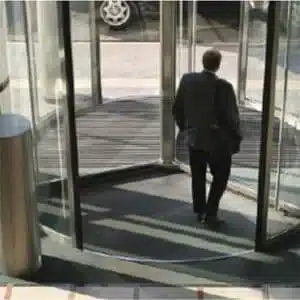
Your front doors are the main entry points through which customers or clients enter your business premises. They’re one of the first things people see of your business and as such, should not only be efficient but present a positive image of your business. So how can you make your business entry points welcoming and impressive, and secure at the same time?
THE ANSWER: door activation sensors.
Door activation sensors give your business an impressive entry point through the efficient control of automatic doors, as well as keep your entry points secure. Through an active infrared sensor, microwave sensor or both, doors automatically open and close for customers or clients, and stay locked when it is no longer operating hours.
Such capabilities are certainly impressive, but these are by no means the only benefits of having an automatic sliding door – here are several others:
1. Easier entrance and exit monitoring
With door sensors as part of your overall business security system, you can better monitor the people coming in and out of your premises. Persons or objects need to be standing within a detection area around entry points in order to trigger sensors and consequently open doors. This guarantees a moment where people can be clearly seen coming in and out of a premises through entry point CCTV cameras.
2. Remote control
Many automatic door sensors have remote controls, which allow you to conveniently set sensor parameters remotely.
3. Energy savings
You might think that having automatic door sensors will only add to your energy costs, but they can actually help lessen them. Indoor heating and cooling systems usually consume the most energy within a building. Having constantly open doors can significantly increase the energy needed for these systems to maintain indoor temperatures.
By installing automatic door sensors, you limit the amount of time that doors remain open, thereby preserving indoor temperature and conserving the energy needed to maintain it.
Many door activation sensors are also very energy efficient in themselves, consuming very little energy to operate efficiently. Some can even distinguish between pedestrian or vehicular traffic and open doors or entryways only up to the size of the opening required, further increasing energy efficiency.
4. Easy entrance and exit for materials and supplies
If your business or facility often receives large deliveries of materials and supplies; or if your business needs to move goods in bulk regularly, door activation sensors are essential. These will allow easy entrance and exit of large, bulky items.
5. Easy entrance for people with disabilities
This is especially necessary for hospitals and other medical facilities where persons are wheeled in on wheelchairs and stretchers, or have disabilities and require assistance when going through doors. Door activation sensors make it so that these people don’t need to exert any effort to go through doors.
6. Lesser maintenance and assorted costs
Because doors or access points need not be touched when door activation sensors are present, damage to doors or sensors due to pedestrian use or direct contact is minimised or even eliminated. This means you spend less time and money on maintenance, and they last longer than most other types of entry systems.
With all these benefits, door activation sensors give you great value for money and are a definite must for every business premises. Make sure your business doesn’t miss out on these benefits– enquire about our range of commercial door activation sensors now by calling (07) 3205 1123.
Access Control Systems Ensure West Gate Tunnel Workers’ Safety

The Monash Freeway upgrade, access improvements for Webb Doc and the $6.7 billion West Gate Tunnel are city-shaping projects that will provide quicker and safer journeys for Melbourne commuters.
West Gate Tunnel – 5 Years in the Making
Providing an alternative to the West Gate Bridge the West Gate Tunnel will be a much needed second river crossing.
Two state-of-the-art boring machines building the twin tunnels started their journey at the northern portal on Whitehall Street, Footscray and are moving south-west towards the southern portals in the West Gate Freeway.
Behind the boring machines, a mobile factory installs a concrete lining, forming the walls, roof and base of the tunnel. Followed by crews of up to 20 people who build the road surface and install electrics, ventilation and safety system.
For more information about the West Gate Tunnel Project visit the West Gate Tunnel webpage
Managing the Workforce
With over 3,000 people currently working on the project keeping track of, managing and protecting every person on site is a mammoth undertaking.
Underground excavation and tunnelling is a high risk, hazardous activity. As such mining operators are responsible for ensuring strict compliance with Occupational Health and Safety regulations to protect workers from injury or death.
Controlling access to high risk or restricted areas and managing the movement of the site-based workforce, contractors and visitors is crucial to the prevention and minimisation of risks to the health and safety of both employees and the public.
A leader in workforce management software as a service, Damstra Technology is providing essential systems for mining operators and other project construction contractors to monitor, manage, keep track and protect their employees.
Australian-made turnstiles – on the job
Requiring reliable, high-performance physical entry and exit barriers that could be teamed with their sophisticated site and access control technology Damstra chose Rotech.
Eight F21 full height turnstiles have been delivered to various tunnel project locations. Their role is to secure perimeters, prevent unauthorised entry and control access to high danger zones.
Rotech’s Australian made TriStar F21 full height turnstiles work seamlessly with the Damstra’s hi-tech workforce management and access control software. Performing a vital role in creating a safe and secure operating environment for all personnel the turnstiles allow:
- Employee swipe cards record arrival and departure times for calculating wages
- The access control system records and monitors who is on site and their location. Critical information in an emergency where site management and safety crews need to know the location and how many personnel on site
- Limits access to one person at a time – there’s no tailgating of an unauthorised person following an authorised one
- A bi-directional turnstile means the TriStar can be set to entrance only, exit only or used in both directions
- High, wide entrance allows easy entry for personnel wearing hard hats and carrying tools.
Rotech
Why Rotech’s TriStar F21 Full Height Turnstile?
The TriStar is the first Australian-made product of its type, created to provide customers with a safe and secure method of access control with multiple optional features and customisation options:
- Ideal for construction sites, a portable base and solar power options allow it to be used in remote locations or situations without access to mains power
- A high-capacity drive mechanism with a 5 year warranty
- Strong galvanised frame and rotor preventing forced entry
- The turnstile roof design prevents unauthorised and unseen entry at unattended exits
- Status indication system provides the ability to see whether the turnstile secure i.e. the entry/exit is closed or freewheeling
- On power failure, the built-in relay automatically initiates the battery back system and sets off a warning siren. This means in situations where power is down the turnstile can continue to function normally for up to 3000 cycles without mains power.
Make an enquiry
If you would like further information about this or other safety and security combinations for your premises call us on 07 3250 1123 or email info@rotech.com.au
SAFEPASS Sensors “Waving” Good-bye to Contamination
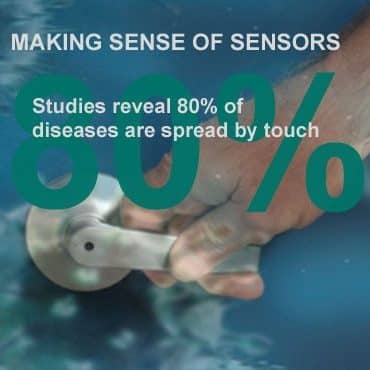
Wave but Don’t Touch! Eliminate cross-contamination and reduce the spread of bacteria, diseases and infections. Advanced “touchless” door activation sensors are an effective solution to safeguarding facilities, employees, customers and patients against unhygienic practices.
Rotech’s SAFEPASS ClearWave and J-Wave touchless door activation sensors incorporate the latest microwave and infrared technologies into a sleek slim line design that makes mounting a breeze.
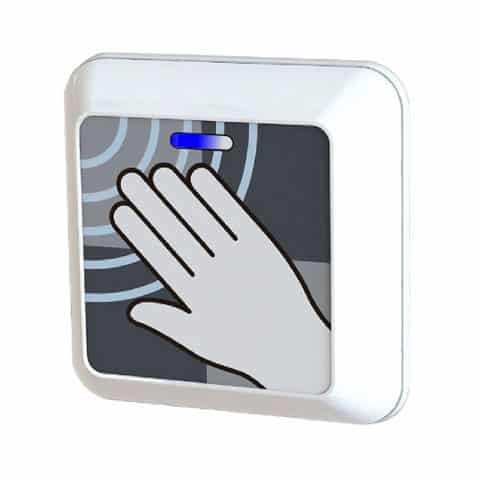
SAFEPASS ClearWave Door Activation Sensor
hygienic, touchless, microwave technology, flush mounted, sleek design, water resistant, versatile
This non-touch door activation switch is used to maintain sterile environments and features an adjustable touchless range from 5-40 cm.
Designed for installations where hygiene is paramount such as hospitals, operating theatres, pharmaceutical facilities, clean rooms, food processing plants and chemical industry applications.
SAFEPASS J-Wave Door Activation Sensor
germ-free, touchless, active infrared technology, jamb style mounting, tough polycarbonate
A non-touch door activation switch with a detection distance of up to 30 cm. Its low profile design facilitates a tidy installation on narrow door frames or guide rails.
Able to detect very fast hand movements in front of the switch body and is illuminated by an LED so it is easily located in dimly lit environments. Designed to reduce the spread of germs and improve accessibility in hospitals, healthcare, industrial, retail and commercial settings.
Use SafePass Sensors with confidence
-
- Minimise return site visits – Fast reaction times, consistent, reliable sensor performance in a wide range of installation and climatic environments.
- Reduce Building Energy Loss – Accurately adjustable detection area reduces false door activation cutting building energy losses by as much as 15%.
- Certification – All SafePass Sensors are TUV certified to DIN18650 Standards.
- Designed for Easy Install – Installation instructions are clearly printed on the sensor body.
- Simple dip switch settings, standard connections across all products, enables commissioning in a matter of minutes.
- Warranty – All active infrared sensors are backed by a 5 Year manufacturing warranty.
- Manufactured in Japan since 1968 – globally recognised as a market leader in the design and manufacture of sensors.
Our range of microwave and infrared advanced technology door activation sensors has all your business entry points covered. Call us to find out which one will best suit your needs.
SafePass Automatic “Door” Learn Sensors
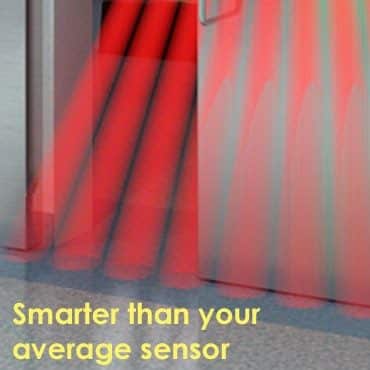
Many people pass through automatic sliding doors in office buildings, shopping centres, hospitals, schools, airports etc every day. Motion and infrared sensors play a critical role in ensuring automatic sliding doors are efficiently and safely while allowing smooth flowing convenient pedestrian access in and out of buildings.
Advances in direction detection and infrared technologies continue to enable better solutions for the safe operation of all kinds of automatic doors operating in a wide variety of environments. Our two active infrared sensor products; the SSR-3 combined technology sensor and the HR100-CT uni-directional active infrared sensor, use unique innovative “door learn technology” to provide unmatched pedestrian safety.
What is “Door Learn Technology” and how does it work?
The unique ability of the “Door Learn” function to memorize door motion and for sensors to look back inside the sliding door leaf allows the door operation to be ignored while anything in the doorway will be detected. The result – an unparalleled level of pedestrian safety.
Active Infrared sensors transmit and measure the reflection levels of infrared light. They have a high immunity to the negative effects of external influences such as reflections, sunlight and artificial light. These sensors are easy to install and adjust and can detect motion and static presence.
- On set up the “Door Learn” function runs. Sensors take a snapshot of the reflection levels from the ground.
- The infrared safety curtain is focused both in front of as well as inside the moving door leaf.
- Three 3 rows of light are changed from motion detection to presence.
- Now any changes in the properties of the reflected wave will indicate that a person or object is in the detection area and cause the sensor relay to activate and the door to open.
SAFEPASS SSR-3 Infrared & Microwave Automatic Door Sensor
With “Door Learn” and uni-directional detecting technology this innovative energy saving sensor can be mounted at heights of up to 3.2m.
A large adjustable detection zone of 4m wide x 4m deep ensures timely door opening for doors approached by shopping trolleys or fast-moving traffic. The EN16005 compliant monitored safety system is also available with an emergency escape route versions.
SAFEPASS HR100-CT Uni-directional Detection Automatic Door Sensor
Using advanced infrared technology this pioneering super sensor offers automatic sliding door activation and unprecedented safety at mounting heights of up to 3m.
The HR100-CT’s easily adjustable detection area eliminates false door openings in busy urban environments. The monitored safety system features dual relay outputs. This ability to adjust the door activation and pedestrian safety detection zones independently makes it the ideal sensor for every sliding door installation.
Use SafePass Sensors with confidence
- Minimise return site visits – Fast reaction times, consistent, reliable sensor performance in a wide range of installation and climatic environments.
- Reduce Building Energy Loss – Accurately adjustable detection area reduces false door activation cutting building energy losses by as much as 15%.
- Certification – All SafePass Sensors are TUV certified to DIN18650 Standards.
- Designed for Easy Install – Installation instructions are clearly printed on the sensor body.
- Simple dip switch settings, standard connections across all products, enables commissioning in a matter of minutes.
- Warranty – All active infrared sensors are backed by a 5 Year manufacturing warranty.
- Manufactured in Japan since 1968 – globally recognised as a market leader in the design and manufacture of sensors.
Our range of microwave and infrared advanced technology door activation sensors has all your business entry points covered. Call us to find out which one will best suit your needs.
Making Sense of Sensors – Domino 1100
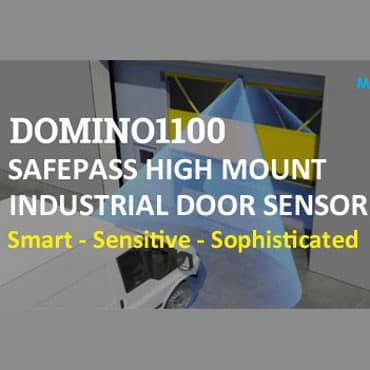
SAFEPASS HIGH MOUNT INDUSTRIAL DOOR SENSOR
Industrial manufacturers, warehouses, distribution centres and commercial operations have been moving away from older slow, rigid doors to high-speed doors in an effort to increase productivity and energy efficiency.
But at what cost? The quest for high-speed high-cycle automation also comes with added safety risks that increased operating speeds can bring to a door opening. Fortunately, these days, most automatic doors use motion detection sensors to manage safety and security in vulnerable areas.
The Domino 1100 Microwave Motion Sensor solution – designed for large high-speed industrial doors, vehicle gates and barriers, vehicle detection, loading docks or any other industrial application where motion detection is required.
SMART – Increasing Pedestrian Safety
The Domino 1100 combines uni-directional detecting technology with intelligent software to differentiate between pedestrians and vehicles.
The ability to identify a pedestrian versus a vehicle allows for different door operation responses, such as partial or full door opening, to be set according to the type of traffic approaching the door.
The ability to configure the Domino 110 to detect different types of activity means the sensor can be used to separate pedestrians and vehicles. Setting the unit to ignore pedestrian traffic while still detecting vehicular traffic forces pedestrians to use a safer side access pedestrian door.
Detection mode is selectable between approach-only or depart-only motion and can also distinguish between cross-traffic and approaching traffic.
SENSITIVE – Fast Moving Vehicle Detection
Featuring microwave sensor technology the Domino 1100 can detect larger objects, such as forklift trucks, up to 60 feet away.
The maximum pattern size of the Domino 1100 is approximately 18 ft. wide and 60 ft. from the unit and is easily adjustable via range potentiometer on the printed circuit board. Uni-directional detecting technology and a large detection area of 5m wide x 8m deep makes the Domino 1100 ideal for the timely detection of fast-moving vehicles.
The mounting height of conventional sensors is around 3-4 metres but the Domino 1100 can be installed at a higher mounting height of up to 7 metres – perfect for taller industrial doors.
SOPHISTICATED – Microwave Technology
Microwave sensors operate by registering and comparing the frequency of transmitted and reflected signals. People and objects cause disparities between the emitted and received frequencies as they move through the detection zone, activating the sensor relay and causing the door to open.
Microwave detectors are motion sensors and can be used in virtually any environment, including those that are not otherwise hospitable to other sensors, making them one of the most versatile types of sensor systems. The Domino 1100 is unaffected by air motion, change in temperature, humidity, color or background variations.
The Domino 1100 is able to be programmed to reduce the number of false door activations without reducing the number of correct positives – improving accuracy, energy losses and ease of use.
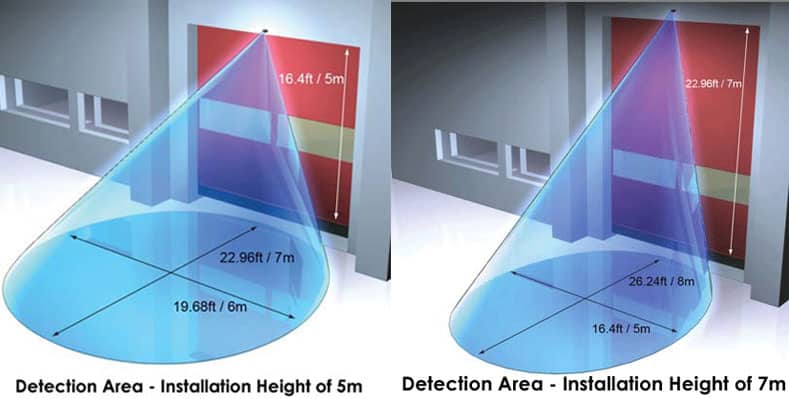
Use SafePass Sensors with confidence
- Reliable – Fast reaction times, consistent, reliable sensor performance in a wide range of installation and climatic environments.
- Designed for Easy Install – Instructions are printed on the sensor body. Simple dip switch settings, standard connections, enables commissioning in a matter of minutes.
- Reduce Building Energy Loss – Accurately adjustable detection area reduces false door activation cutting building energy losses by as much as 15%.
- Certification – All SafePass Sensors are TUV certified to DIN18650 Standards.
- Warranty – All active infrared sensors are backed by a 5 Year manufacturing warranty.
- Manufactured in Japan since 1968 – globally recognised as a market leader in the design and manufacture of sensors.
Contact us if you want to know more about the SafePass Domino 110 or any of our other sensors.
Building Security: Preventing and Detecting Unauthorised Access
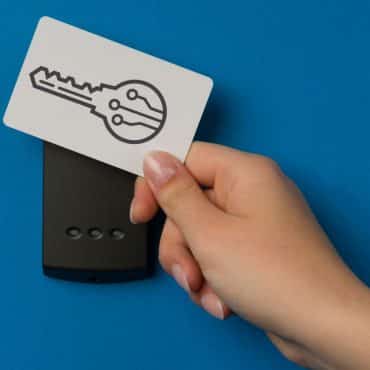
Every business, building or site is different. The best Access Control Equipment for you may not be the same as for the business next door. The best way to prevent and detect unauthorised access is by identifying and understanding your particular security weak spots.
So what are the most common weak spots for unauthorised access into buildings and how do you prevent them?
Tailgating
Tailgating is probably the easiest way to gain access to a building without authorisation. The perpetrator just waits for someone to enter and follows behind them. Many people will even hold the door open for an unauthorised person out of politeness.
Training your staff on this matter is a good prevention method. Creating a culture in the office of politely questioning anybody they don’t recognise will reduce the risk of unauthorised access. This does leave significant room for error however and in larger companies, may not be realistic.
Turnstiles or Flap Barriers are a good way of eliminating tailgating. They only allow one person to enter at a time which slows foot traffic down and allows front of house staff time to observe and identify people as they arrive.
Turnstiles with swipe cards, camera or intercom features will add the extra level of security by only allowing access to authorised personnel and eliminating an intruder’s opportunity to tailgate behind them.
Door Propping
Humans are always looking for the most convenient way to do something, it’s in our nature. You could invest in the most high-tech control access equipment but if people are propping the door so that they don’t have to keep opening it, your systems are suddenly redundant.
Some access control systems can now detect when a door is propped open and alert security accordingly. Another way to resolve the issue is to invest in automatic doors complete with state of the art door sensors.
Keys and Access Cards
Giving keys to staff members makes you vulnerable to human error. People lose keys, misplace them or they can easily be stolen. Many people also have key-rings with the company’s name on them which makes it easy for burglars to identify your building as a target should the keys fall into the wrong hands.
Access cards are the more advanced version of keys as they are registered to a particular person. Cards can track who entered the building and when and can also be used as identification if a photo is included. It is usually easier and cheaper to block access to a card than it is to replace all of the locks should a key or card be lost.
Cards are however still susceptible to human error. To minimise the risk, ensure that the company name or address is not visible so that if it is lost, misplaced or stolen, the building cannot be identified.
What Access Control Equipment Should I Use?
Ultimately, most types of security systems have their own weak spots and your best option may be to utilise multiple security measures in conjunction with each other in order to truly minimise risk. Look at our catalogue of security and access control equipment to find the right combination for you.
What are your weak spots when it comes to Building Security? Leave a comment below, or for expert advice on the best security measures for your building, contact us today.
Improving Safety and Security with Turnstiles
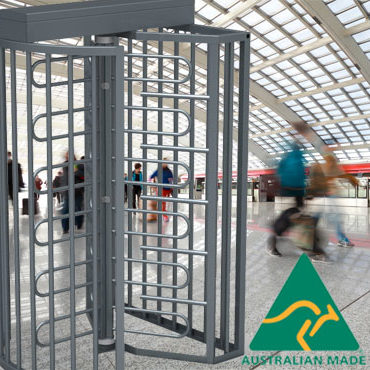
Controlling access is one of the greatest security and safety challenges for property and event managers. They have a responsibility to protect customers and their own staff from threats ranging from armed robbery right up to terrorist attacks.
The great benefit of turnstiles is that only one person at a time can enter a building or enclosure – there’s no tailgating of an unauthorised person behind an authorised one.
This means turnstiles have a major part to play in creating a safe environment for staff and customers, whether it’s at industrial premises, a sports event, concert or even a Boxing Day sale.
In fact, Security Magazine reported in January that sales of turnstiles have increased markedly in the past few years because of increased security fears around the world.
The benefits of turnstiles
Turnstiles slow foot traffic, giving security and reception staff a chance to spot trouble before it occurs. They monitor and manage the movement of visitors and staff, permitting a steady flow of people so tickets can be checked, passes validated and numbers counted.
The modern breed of turnstiles can be integrated with other security features such as swipe cards or cameras, with employee time cards to record arrival and departure times, and with bar code readers to detect pilfering and theft on exit.
They can also be used to prevent unauthorised entry – whether intentional or not – to secure or dangerous areas such as construction, industrial or mining sites.
Australian-made turnstiles with Rotech
Rotech’s TriStar Full Height Turnstile is the first Australian-made product of its type and comes with multiple security and safety options.
- It is bi-directional and can be set to entrance only, exit only or used both ways, then locked outside opening hours.
- A soft start and stop feature makes it easy to use, even for a small child.
- High, wide entrance allows easy entry for personnel wearing hard hats and carrying tools.
- The frame and rotor are galvanised, and stainless steel is an option.
- High-capacity drive mechanism supports all types and sizes of rotating arms.
- Battery back-up can operate the turnstile to for up to 3000 cycles during power outages.
- Turnstile roof prevents unauthorised and unseen entry at unattended exits.
- Compatible with all access control systems.
- Can incorporate an alcohol breathalyser to prevent entry to working sites by personnel who have been drinking.
- Optional solar panel operation for remote areas or building sites.
Rotech prides itself on bringing the latest trends in automated security to Australia. Contact us to discuss how our turnstiles can help boost safety and security at your premises or major event.
How Retail Gates Can Help Stop Thieves in Their Tracks
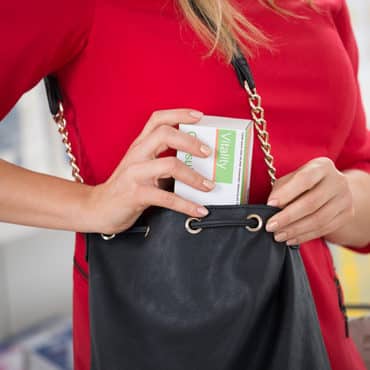
Theft is a key concern for retail businesses around the world. Figures from the Global Retail Theft Barometer, published by Inside Retail, reveal that shoplifting and employee theft are the biggest causes of retail shrinkage, which costs Australian retailers nearly $3 billion every year.
Let’s take a look at some trends in retail theft, and how retail security gates can help supermarkets and other retail stores to deter thieves.
Risk factors and trends in retail theft
The Australian Institute of Criminology (AIC) states there are a number of risk factors and trends in retail theft. These include:
- Store floorplans with numerous exits and easy-access change rooms can give sticky-fingered shoppers the chance to conceal goods and slip out undetected.
- Stores without security guards or gates have an increased theft risk.
- Teenagers make up a huge chunk of the shoplifting population.
- Catching shoplifters is difficult and rarely happens.
- Background checks and well-communicated anti-theft policies can be useful in cutting down on employee theft.
The role retail security gates can play in deterring theft
According to the AIC, research shows that access control is one of the most effective measures, alongside employee education, for reducing theft within a retail setting. Interestingly, the combined research studies note the impact of standalone CCTV as unclear and suggests it is most effective when implemented as part of a larger multi-faceted approach, while access control showed marked effectiveness on six out of seven occasions.
How Rotech can help
At Rotech, we specialise in access control solutions. Our Bulwark HB automatic supermarket gate is a functional and reliable access solution for all retail environments, including:
- Supermarkets
- Pharmacies
- Liquor stores
- Automotive and discount stores
- Gymnasiums and sporting venues
The Bulwark is safe, fast and secure, featuring electronic sensing monitors, adjustable microwave radar that allows for fast opening as soon as a person is detected, anti-tampering mechanisms that sound an alert if someone tries to force the gate and can be reset without expert knowledge, and a durable 6mm thick steel housing.
The chrome finish looks polished and attractive, and suits all retail settings. You can even add matching barrier rails and posts to guide customers beyond the pay point. Set up couldn’t be simpler. Operating optimisation and testing occurs in our workshop, allowing for an economical installation at your premises.
When it comes to retail theft, the old adage about prevention being better than cure rings true. When shoplifters or thieves aren’t caught, goods aren’t recovered. Restricting access with an automatic gate makes it harder for a thief to abscond – so much harder they might even reconsider pilfering the product in the first place.
The Bulwark HB automatic supermarket entrance gate is one of many solutions in Rotech’s range of retail security gates. Talk to us about how we can help you reduce the risk of theft in your retail business.


